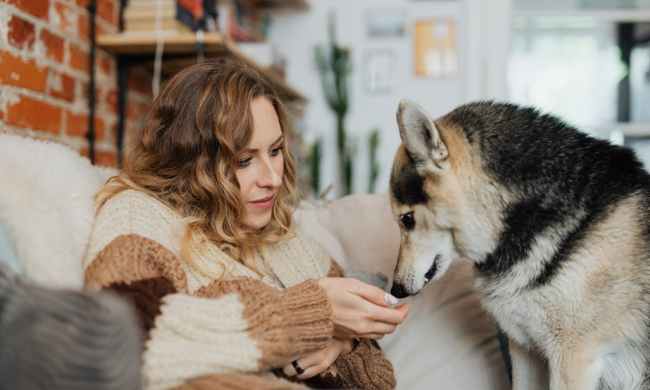Every year on your birthday, (hopefully) you get a special dessert. It seems only fair that your pup be allowed the same treat, which may require you to whip out the ingredients. Of course, you can always go for a Puppuccino together, but if you want to give it a little extra, consider creating a dog-friendly cake for the occasion. These concoctions can work out for even a novice baker and will leave both of you thrilled with the results and hungry for more (most dog birthday cakes are edible to humans as well!).
What ingredients should go into a dog-friendly cake?

You may want to pick a staple that your dog loves and build the cake around it. While we’re including a dog birthday cake recipe below, you can absolutely mix it up depending on Fido’s preferences. Focus on things like pumpkin, peanut butter, yogurt, carrot, and banana.
All these things will settle just fine into your pup’s stomach and won’t cause any issues. Of course, you might want to hold back on other treats since they’ll devour such a delicious helping of birthday cake (or let them go over their calories for just one day).
What shouldn’t you include in your cake?

Never feed a dog a human cake. There’s way too much sugar, salt, and fat in there for your beastie. Additionally, you want to avoid anything pooches have a bad reaction to. The top of this list is chocolate, which you need to leave out no matter what. However, it doesn’t stop there. Dogs also can’t eat grapes/raisins, xylitol, and avocado. Never include these ingredients in any treats for your pet, and read packages of prepared foods, like peanut butter, carefully to ensure you don’t mistakenly provide one of the toxic foods.
How do you make a cake for your dog?

Once you have all your ingredients picked out and have chosen your recipe, put together the cake in a few easy steps. For this one, we’re using:
- 1 egg
- 1/4 cup peanut butter
- 1/4 cup cooking oil
- 1 teaspoon vanilla extract
- 1 cup shredded carrots
- 1 cup whole wheat or white flour
- 1 teaspoon baking soda
Get set up
Pull out your ingredients and your mixing bowls. Feel free to use just a couple spoons and a cake tin. You don’t need anything fancy. While you’re getting this all set up, preheat the oven to 350 degrees Fahrenheit and grease your pan.
Mix the ingredients
Mix together the egg and peanut butter, or whatever else you have decided to use, in a mixing bowl. Once you have this creation prepared, you can add the carrots or any other vegetable of your choosing. Lastly, incorporate the flour and baking soda so it’s more cake like.
Put into the oven
Get the batter into the cake pan (remember it’s not safe to eat until it cooks because of the raw egg and unheated flour). Put the tin into the oven and set a timer for 40 minutes. You want to check the cake and see if it’s done with the toothpick test.
Reveal your masterpiece
Pull out your cake and let it sit in the tin for 10 minutes. Then get it out of the tin and place it onto a cooling rack. Of course, allow it to cool down to a reasonable temp before serving to your pet — or yourself.
What flour is safe for a dog cake?

We already covered the main fixings that our furry friends can’t digest, but what about flour? It’s all good news here: Most flours you eat are safe for your animals. You can grab whole wheat, white, chickpea, oat, or almond for your mixture, depending on your own preferences and diet (we expect the birthday pup to be so thrilled by the dessert that they won’t notice which you chose). Naturally, they could have some intolerances that you must take into account as well. Lastly, a lot of dog bakers stay away from all-purpose flour. It won’t hurt, but doesn’t have a lot of nutritional value.
The next time your best friend’s b-day comes, you’ll be ready to bake them a delicious cake. For even better results, invite over their besties and make sure you have enough to share (that may involve doubling or even tripling the recipe). You can also take any dog cake and split it up into cupcakes using a muffin tin. When you run out of time to create something so elaborate, stick with their favorite treat or find a local bakery that carefully creates pet-safe goods. They won’t wind up too picky when the time comes to eat their celebratory snack.




